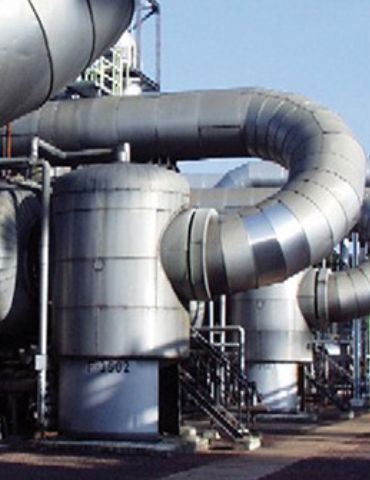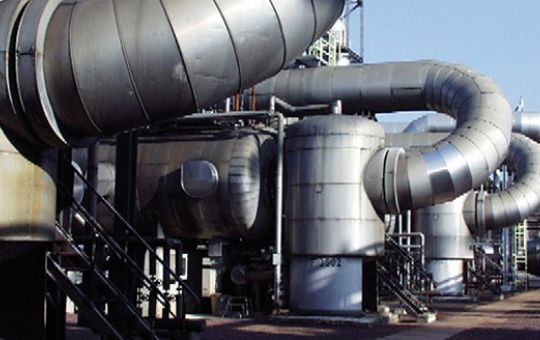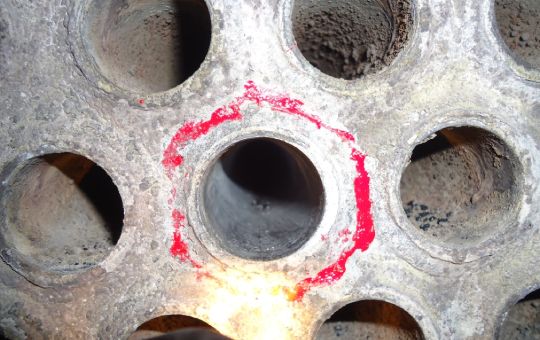Suitable Products
Mini-TubeMaster
TubeMaster
JetMaster/ JetMaster AS


Gas and Oil Production
Examples of applications in gas and oil production
Current application examples from gas and oil production. TubeMaster from mycon GmbH cleans tube bundle heat exchangers, especially for the desulphurisation of gas and oil. Since dry cleaning takes place, sulphuric acid cannot form in the tubes afterwards. The inner walls of the pipes can be additionally polished in a single operation. This ensures excellent heat transfer and a longer service life.
Cleaning of tube bundle heat exchangers using the TubeMaser of mycon GmbH
Sulfurcrete consists of elemental sulfur, salts formed from sulfur plus CO2, SO2, NH3 and dust from the attrition of Claus catalysts. The hardness of this material corresponds to that of granite (see e.g. /1/). Almost every Claus plant operator knows the annoying problems that sulfur crete causes. Primarily, sooner or later it clogs the pipes in sulfur condensers. Traces of sulfuric acid form beneath the surface of the sulfurcrete layer, leading to corrosion. Both effects are of course extremely unfavorable and therefore sulfur crete must be removed.
However, this is a very difficult task. Sulfur crete forms in relatively cool areas of Claus systems, particularly in sulfur condensers. In Claus systems they are typically operated in the temperature range from 125°C to 160°C. At higher temperatures, the sulfur becomes highly viscous and therefore does not flow freely out of the condenser. At temperatures lower than 125°C, the temperature difference to the sulfur solidification point of approx. 119°C becomes too small. The lower the temperature, the lower the vapor pressure of the sulfur, and therefore sulfur condensers are in principle more efficient at low temperatures. However, the salts that form in the heat exchanger during sulfur condensation are then more stable, making higher temperatures preferable. The optimum is therefore usually to operate the sulfur capacitors at the upper end of the feasible range. In particular, the formation of CO2 salts of ammonia can be avoided by operating at temperatures above 150°C. But what remains are stable SO2 and SO3 salts of ammonia, dust from catalyst debris and sulfur droplets that tend to clog the capacitors.
Operating at higher temperatures can make operations easier, but comes at the expense of reduced sulfur recovery because some of the sulfur vapor flows through the condenser unprocessed. Given current strict regulations on sulfur recovery, this is often not an acceptable option. Whatever operators try to overcome the problem of clogging in sulfur condensers, all they can achieve is reducing the problem, not actually solving it: sooner or later, the pipes in the sulfur condensers contain sulfur crete deposits and can eventually even become clogged. The problem is compounded by the hardness of sulfur crete, which is equivalent to that of granite.
Cleaning processes that use water are prohibited when cleaning sulfur capacitors. The resulting acid formation leads to severe corrosion of the inner pipe surfaces, not to mention the traditional method for removing sulfur crete is to drill the layer out of the pipes. This inevitably leads to smaller or larger scratches on the surface of the pipes, which then serve as preferred locations for the formation of new deposits. Major damage can also occur if the drill bits deviate from course and penetrate the steel pipe instead of removing the deposits. Since sulfur condenser tubes are usually made of carbon steel, some corrosion will always occur after a long period of operation. Corroded areas are particularly susceptible to fractures due to the mechanical stress of drilling. Finally, many sulfur condensers use U-tubes, and the curved part of the tubes cannot be reached by drilling. This means that some of the pipes remain unclean and the useful life of this heat exchanger is shortened. With “TubeMaster” all these problems can be overcome. However, with U-tubes, the performance of the TubeMaster must be reduced to avoid damage to the bend area.
The special jet nozzle of the TubeMaster system, which is specially tailored to the contamination of the heat exchanger, is moved through the tube at approx. 3 to 12 m/min, driven by the carrier gas. The speed is controlled depending on the required cleaning effect and must be adjusted individually for each application. It depends on many parameters, such as the material of the deposits, the thickness of the deposit layer and its hardness.
Where other processes give up when cleaning sulfur capacitors due to the granite-hard deposits, TubeMaster shows its full quality. Major customers in the Gulf States have been successfully using TubeMaster – especially the automated version TubeMaster AS – for several years.
Application Examples

Condenser cleaning for desulfurization in gas production

